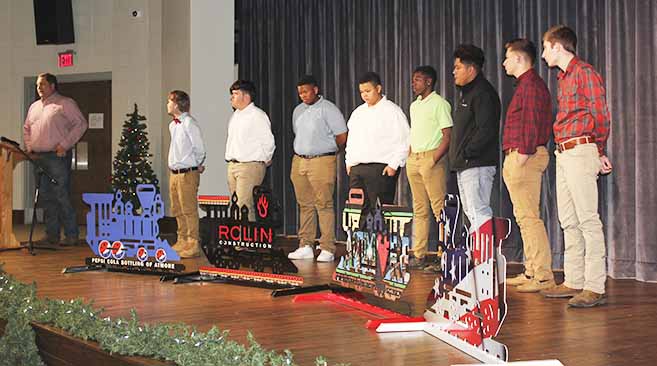
By DON FLETCHER
News Staff Writer
Atmore Area Chamber of Commerce officials and numerous guests not only unveiled the latest effort at local marketing and workforce development during a December 17 ceremony. They also praised the young men who created the trains as an example of how bright the community’s future looks.
The adults joined a design team that consisted of eight Escambia County High School welding students, most of whom are dually enrolled in Coastal Alabama Community College’s (CACC) high-technology welding program, in presenting the results of the group’s handiwork.
The event, held at ECHS’s Hodnette Auditorium, was to display the first four of 17 steel trains that will eventually be displayed throughout the Atmore area. The display will be similar to the Pelicans in Paradise initiative that resulted in the placement of pelican statues throughout Pensacola.
“When I was interviewing with the Chamber, we were talking about how people needed to get the word out,” Chamber Executive Director Emily Wilson said. “I popped off and said, ‘If Pensacola can have pelicans, why can’t Atmore have trains?’ Dale Ash put me in touch with Lee Jernigan, and Lee put us together with these gentlemen in the first row.”
Wilson was referring to the team of Escambia County High School students who designed and fabricated the four trains on display. That team consisted of Joey Ramer, who was the lead welder and in charge of the project; Hayden Weaver, the project’s second in command; Fredrick Rudolph; Elijah Mallory; Xavier Finney; Aaron Calva; Steven Schubering, and Antonio Schubering.
“This was completely their concept,” Wilson pointed out. “We said we wanted a train; they designed it and cut it. That is amazing. This is a tangible, life-touchable explanation of what our young talent here in Atmore can do.”
Funding for materials and other costs was provided through a grant from Gulf Coast Resource Conservation and Development Council.
The trains were those sponsored by Pepsi Cola Bottling of Atmore, Rolin Construction, the Chamber of Commerce and United Bank. The remainder will include 12 more stand-alones and five others that will serve as bicycle racks. Each is approximately four feet wide and three feet tall. They are built of 10-gauge steel and 1-1/2-inch steel tubing.
Wilson praised Escofab, from which the materials came, as well as John’s Paint & Body, which prepped, primed and powder-coated the trains, and Landis Design Co., which did the “wrapping” that sealed the paint to the metal.
Jernigan said he initially felt the idea was a “fairy tale.” And like most fairy tales, this one had a happy ending, largely due to Ramer’s effort.
“Joey Ramer took it from a fairy tale to this,” the welding instructor said, pointing to the four creations. “We had other projects going on, so he had to actually learn the CNC (Computer Numerical Control) machine by himself. He told me to just give him a computer and he would figure it out. He did an amazing job. The kids really jumped in and took ownership of the project. Joey and Hayden took the lead; the others just fell right in.”
State Rep. Alan Baker said of the group’s effort, “It gives me goose bumps and chills to see the work you all have done and the planning that went into this,” while County Commissioner Scottie Stewart, who is a member of the RC&D Council, said the trains represented “just good, quality work” and the “future of our community.”
ECHS Principal Dennis Fuqua noted that the CNC machine was donated to ECHS by CACC, which was going to scrap it. He praised the young design and welding team and said they represented not only the backbone of the community’s future workforce, but also the value of technical education.
“I can’t brag enough about this group of young men,” Fuqua said. “Here’s the reality of the situation: They and their families will never go hungry, because they know how to work, know how to use their hands, and they will see a project through.
“They might not knock out the top on a standardized test, but they are going to make a living and be productive Atmore citizens. They are the kind of young men, when you see them in the hallways, you can have more than just a principal-student relationship. They really understand what’s going on; they understand the bigger picture.”
